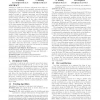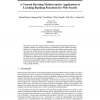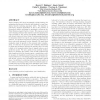39 search results - page 7 / 8 » Label ranking by learning pairwise preferences |
CIKM
2008
Springer
13 years 6 months ago
2008
Springer
Learning-to-rank algorithms, which can automatically adapt ranking functions in web search, require a large volume of training data. A traditional way of generating training examp...
KDD
2008
ACM
14 years 5 months ago
2008
ACM
Learning to rank from relevance judgment is an active research area. Itemwise score regression, pairwise preference satisfaction, and listwise structured learning are the major te...
NIPS
2007
13 years 6 months ago
2007
We present a general boosting method extending functional gradient boosting to optimize complex loss functions that are encountered in many machine learning problems. Our approach...
SEKE
2004
Springer
13 years 10 months ago
2004
Springer
Requirements prioritization plays a key role in the requirements engineering process, in particular with respect to critical tasks such as requirements negotiation and software re...
KDD
2010
ACM
13 years 6 months ago
2010
ACM
Active learning (AL) is an increasingly popular strategy for mitigating the amount of labeled data required to train classifiers, thereby reducing annotator effort. We describe ...



